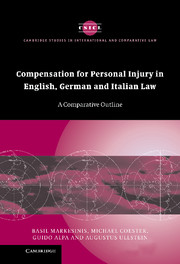Book contents
- Frontmatter
- Contents
- Foreword
- Preface
- Table of cases
- List of Abbreviations
- 1 Introduction
- 2 General damages: non-pecuniary losses
- 3 Special damages: past losses
- 4 Future pecuniary losses
- 5 Collateral sources of revenue: subrogation rights and miscellaneous matters
- 6 Conclusions
- Appendix: Comparative tables on the evaluation of physical injury (IP) for micro-permanent injuries
- Index
- CAMBRIDGE STUDIES IN INTERNATIONAL AND COMPARATIVE LAW
1 - Introduction
Published online by Cambridge University Press: 02 July 2009
- Frontmatter
- Contents
- Foreword
- Preface
- Table of cases
- List of Abbreviations
- 1 Introduction
- 2 General damages: non-pecuniary losses
- 3 Special damages: past losses
- 4 Future pecuniary losses
- 5 Collateral sources of revenue: subrogation rights and miscellaneous matters
- 6 Conclusions
- Appendix: Comparative tables on the evaluation of physical injury (IP) for micro-permanent injuries
- Index
- CAMBRIDGE STUDIES IN INTERNATIONAL AND COMPARATIVE LAW
Summary
Preliminary observations
Cross-border claims for personal injuries are becoming more and more common, particularly within the European Union. Furthermore, we know from our personal experience that European nationals and/or residents increasingly join, or seek to join, class actions in the United States of America. This tendency leads to a need to know more about the law in Europe including, of course, English law. Thus, though this book is not about American law, it makes allusions to it where this is likely to be useful to both American lawyers using it and Continental European lawyers aware of the fact that they must constantly guard against the danger of thinking that they understand the law in the USA because they usually know something about English law.
Despite the growing importance of this subject, we believe that there is a dearth of material available to practitioners in any of these jurisdictions to assist them both in advising their clients as to the heads of damage recoverable in other countries and/or the level of damages which they might expect to be awarded. It is the objective of this book to fill that gap in sufficient (but not excessive) detail and we attempt this in chapters 2 to 5. If the transnational trend we alluded to above continues, we intend to flesh out our account further in a future edition.
In this work we have deliberately limited the scope to compensation for personal injury.
- Type
- Chapter
- Information
- Compensation for Personal Injury in English, German and Italian LawA Comparative Outline, pp. 1 - 44Publisher: Cambridge University PressPrint publication year: 2005



